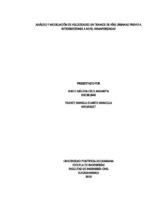| dc.contributor.advisor | Pico Vargas, Ricardo | |
| dc.contributor.author | Celis Angarita, Angie Melissa | |
| dc.contributor.author | Duarte Mancilla, Francy Daniela | |
| dc.coverage.temporal | 2019 | |
| dc.date.accessioned | 2021-05-07T15:13:14Z | |
| dc.date.available | 2021-05-07T15:13:14Z | |
| dc.date.issued | 2019 | |
| dc.identifier.uri | http://hdl.handle.net/20.500.11912/8457 | |
| dc.description | 140 páginas | spa |
| dc.description.abstract | Para la ingeniería civil es fundamental el análisis de la infraestructura vial, ya que a.través de esta se aporta a la movilidad y seguridad vial de cada uno de los ciudadanos. El presente trabajo de grado pretende desarrollar ecuaciones de predicción de velocidad en vías urbanas previo a intersecciones semaforizadas analizando los principales factores que influyen sobre la velocidad de operación. Es así como, en la ciudad de Bucaramanga, específicamente en las carreras 27 y 22, se recolectaron datos de velocidad de 40 vehículos utilizando el equipo de GPS Video VBox Lite, se tomó información necesaria sobre las características del vehículo y se aplicaron encuestas de estilo de conducción (MDSI-S) y rasgos de personalidad (ZKPQ-50-cc) a cada conductor para analizar la influencia del factor humano. A través de un levantamiento topográfico se analizaron variables corno longitud total de cada tramo, número de carriles, ancho de calzada y ancho de carril, de igual forma se tuvo en cuenta las características del entorno en cuanto a cantidad de árboles, postes, accesos y señales de tránsito. La deducción de los cálculos obtenidos como resultado se llevó a cabo a través de programas y directrices para una valoración eficiente de los datos. | spa |
| dc.description.abstract | For civil engineering, the analysis of road infrastructure is essential, since it contributes to the mobility and road safety of each citizen. The present degree work intends to develop equations of prediction of speed in urban roads before traffic lights intersecting analyzing the main factors that influence the speed of operation. Thus, in the city of Bucaramanga, specifically in races 27 and 22, speed data were collected from 40 vehicles using the GPS Video VBox Lite equipment, necessary information about the characteristics of the vehicle was taken and surveys of style of conduction (MDSI-S) and personality traits (ZKPQ-50-cc) were applied of to each driver to•analyze the influence of the human factor. Through a topographic survey, variables such as total length of each section, number of lanes, road width and lane width were analyzed, in the same way the characteristics of the environment were taken into account in terms of number of trees, posts, accesses and Road signs. The deduction of the calculations obtained as a result was carried out through programs and guidelines for an efficient assessment of the data. | eng |
| dc.format.mimetype | application/pdf | |
| dc.language.iso | spa | |
| dc.publisher | Universidad Pontificia Bolivariana | spa |
| dc.rights | Attribution-NonCommercial-NoDerivatives 4.0 International | * |
| dc.rights.uri | http://creativecommons.org/licenses/by-nc-nd/4.0/ | * |
| dc.subject | Velocidad | spa |
| dc.subject | Topografía | spa |
| dc.subject | Semáforos | spa |
| dc.subject | GPS | spa |
| dc.subject | Carreteras | spa |
| dc.title | Análisis y modelación de velocidades en tramos de vías urbanas previo a intersecciones a nivel semaforizadas | spa |
| dc.type | Trabajo de grado | spa |
| dc.publisher.department | Escuela de Ingenierías | spa |
| dc.publisher.program | Ingeniería Civil | spa |
| dc.type.hasVersion | publishedVersion | spa |
| dc.description.sectional | Bucaramanga | spa |
| dc.description.degreename | Ingeniero Civil | spa |


